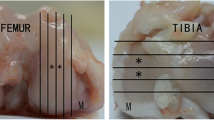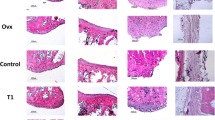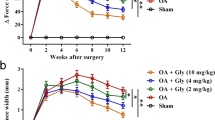Abstract
To investigate the in vivo effect of dehydroepiandrosterone (DHEA) on the expression of aggrecanases and their endogenous inhibitor in a rabbit model of OA. Ten New Zealand white rabbits underwent bilateral anterior cruciate ligament transection (ACLT). One knee of each rabbit was randomly assigned to receive 100 μM DHEA dissolved in dimethylsulphoxide (DMSO) and the other was treated with DMSO only. The treatment was given once a week for 5 weeks, starting 4 weeks after transection. All rabbits were euthanized 9 weeks after ACLT treatment, and the knee joints were evaluated by gene expression analysis. Intra-articular administration of DHEA significantly reduced the gene expression of aggrecanases, while markly increasing that of tissue inhibitor of metalloproteinase-3 (TIMP-3), an endogenous inhibitor of aggrecanases. DHEA may have beneficial effects on OA by influencing the balance between aggrecanases and TIMP-3 through which DHEA may protect against OA.
Similar content being viewed by others
Avoid common mistakes on your manuscript.
Introduction
Osteoarthritis (OA) is one of the most common joint diseases affecting the elderly population. It is characterized by progressive destruction of the articular cartilage and concomitant changes in the subchondral bone. Currently, there are many treatments available for OA. Conservative measures begin with lifestyle modifications, such as weight loss and decreased activity. Current medications for OA, including nonsteroidal anti-inflammatory drugs [1, 2] or steroids [3], provide only symptomatic improvements. A relatively new treatment, hyaluronan injection, improves joint lubrication and can decrease pain [4]. The major disadvantage of all current treatments is that they mainly target the symptoms of OA but do not address the fundamental mechanisms by which articular cartilage damage develops. Consequently, a novel treatment capable of protecting or regenerating cartilage would be desirable.
Dehydroepiandrosterone (DHEA) is a 19-carbon steroid hormone that is classified as an adrenal androgen. Because it declines with age, DHEA is known as an ‘antidote for aging’, and a number of studies have examined its role in atherosclerosis, cancer, diabetes, obesity, and aging [5–9], as well as in inflammatory arthritis, such as rheumatoid arthritis (RA) [10]. Although RA shares some clinical aspects with OA, there is limited information about the effects of DHEA on OA.
ADAMTS-4 (also known as aggrecanase-1) and ADAMTS-5 (also known as aggrecanase-2) have been identified as the most efficient degraders of aggrecan [11–14]. Matrix metalloproteinases (MMPs) and aggrecanases are both members of the broader family of metalloproteinases, the predominant host enzymes responsible for cleaving extracellular matrix (ECM) proteins [15]. Suppression of some MMP family members by DHEA has been demonstrated in OA [16, 17]; however, the direct effect of DHEA on aggrecanases remains unknown. A increasing line of evidence indicated that therapies aimed at preventing aggrecan loss by inhibiting aggrecanase activity could slow progressive cartilage erosion and delay, or even prevent, the development of end-stage disease [15, 18]. Thus, in the present study, we investigated the effect of DHEA on the mRNA expression of aggrecanases, which have recently been considered as potential therapeutic targets in OA [11, 15].
Materials and methods
Reagents
DHEA was purchased from Fluka (USA) and used at a concentration of 100 μmol/l dissolved in DMSO. This concentration had a protective effect against articular cartilage loss and no toxic effects on chondrocytes [16].
Animals and treatment
The model used to study the development of OA in this research was the ACLT model. Previous study has shown this method produces reliable and reproducible degradation of articular cartilage after 9 weeks [19].
Ten one-year old male New Zealand white rabbits with no clinical or radiographic evidence of joint disease were used for the study. All experiments were conducted with the approval of the Institutional Animal Care and Use Committee. All rabbits were anaesthetized intravenously with 3% sodium pentobarbital (1 ml/kg), and underwent bilateral anterior cruciate ligament transection (ACLT). The anterior drawer test was performed to confirm complete transection of this ligament. After surgery, each rabbit was placed in a cage (60 × 60 × 40 cm3) without any immobilization. The rabbits were administered 400,000 units of penicillin daily for 3 days after surgery. Four weeks after transection, one knee of each rabbit was randomly selected to receive 100 μmol/l DHEA in DMSO, and the other knee was treated in the same manner using only DMSO once a week for 5 weeks. All rabbits were sacrificed 9 weeks after ACLT treatment, and the knee joints harvested were randomly divided into two equal groups of 10, one control (treated with DMSO) and the other experimental (treated with DHEA in DMSO). The cartilage tissue from all the knee joints were evaluated by gene expression analyses.
Real-time quantitative reverse transcription–polymerase chain reaction (RT–PCR)
Cartilage tissues from the medial femoral condyle (MFC) were harvested from the knees, and total RNA was extracted using Tri reagent (Sigma–Aldrich) according to the manufacturer’s instructions. After treatment during 20 min at 37°C with 1 unit of DNase I (Sigma–Aldrich) to prevent genomic DNA contamination, 1 μg of total RNA was reverse transcribed using 1 μg of random hexanucleotide primers (Promega), 0.5 mM dNTPs, and 200 units of Moloney murine leukemia virus reverse transcriptase (Promega) at 37°C for 1 h in the appropriate buffer. The reaction was stopped by incubation at 70°C for 10 min. Then, quantitative RT–PCR analysis was performed using the iCycler apparatus (Bio-Rad). iQTM SYBR Green supermix PCR kit (Bio-Rad) was used for real-time monitoring of amplification (5 ng of template cDNA, 45 cycles: 95°C/10 s, 60°C/25 s) with the primers listed in Table 1. Accurate amplification of the target amplicon was checked by performing a melting curve. Using rabbit 18S rRNA (sense 5′-GACGGACCAGAGCGAAAGC-3′; anti-sense 5′-CGCCAGTCGGCATCGTTTATG-3′) primers, a parallel amplification of rabbit 18S transcript (genbank) was carried out to normalize the expression data of the ADAMTS-4, ADAMTS-5, TIMP-3 and aggrecan transcript respectively. The relative level of these selected gene expression is calculated for 100 copies of the 18S housekeeping gene following the formula: n = 106 × 2(Ct 18S _ Ct targeted genes).
Statistical analyses
All data are expressed as mean mRNA expression ± standard deviation using unpaired Student’s t test. P < 0.05 was considered as statistically significant.
Results
Real time RT–PCR analysis
Rabbit 18S rRNA was evenly expressed in all samples, confirming the uniformity of the RNA preparation. Biochemically, the DHEA-treated cartilage showed some increased expression of anabolic genes and decreased expression of catabolic genes when compared with the control group. The anabolic gene, aggrecan and TIMP-3, had a higher expression in the experimental group when compared with the control group (P < 0.01; P < 0.01). Two catabolic genes were tested in the cartilage: ADAMTS-4 and ADAMTS-5 showed lower expression in the DHEA-treated group when compared with the control (Fig. 1) (P < 0.05; P < 0.01).
Real-time RT–PCR data of the expression of anabolic and catabolic genes in the cartilage tissue of the control and DHEA-treated groups are shown. The DHEA-treated cartilage showed an increase in TIMP-3 and aggrecan expression (P < 0.01) and decrease in ADAMTS-4 (P < 0.05) and ADAMTS-5 (P < 0.01) expression when compared with the control group (*Compared with the control group, P < 0.05; **Compared with the control group, P < 0.01)
Discussion
In this study, we surgically induced OA in rabbits by ACLT. The use of experimental ACLT models is of particular clinical relevance, since rupture of the ACL occurs in humans and also leads to the development of OA [20]. Rabbit ACLT is increasingly being used in OA studies because disease onset is rapid [21, 22]. This OA model demonstrates biochemical and pathological changes identical to those found in human OA, and it also permitted an in-depth analysis of the role of proteolytic enzymes in OA progression, which is hard to achieve using human OA specimens [23].
Several members of the ADAMTS family have been shown to cleave aggrecan at the aggrecanase cleavage site [24]. Of these, ADAMTS-4 and ADAMTS-5 are the most efficient aggrecanases that have generally been considered the most likely factors involved in the pathological mechanisms of OA [25]. Recent knockout mouse studies strongly suggested that gene deletion of ADAMTS-4 and ADAMTS-5 provided significant protection against proteoglycan degradation ex vivo and decreased the severity of OA [26–28]. These studies convincingly demonstrate that ADAMTS enzyme activity targeting may protect against the development of cartilage lesions in experimental OA. Inhibition of these enzymes may be a potential therapeutic strategy for OA.
Several studies have provided important evidence for TIMP-3 as a potent endogenous inhibitor of aggrecanases, which play a key role in the degradation of articular cartilage aggrecan [29]. In the present study, we found that DHEA obviously suppressed the mRNA expression of ADAMTS-4 and ADAMTS-5 and enhanced the mRNA expression of TIMP-3 in the OA cartilage. The data in present study suggest that DHEA may influence the balance between aggrecanases and TIMP-3 to produce a protective effect in OA. Although this is not the first report demonstrating the protective effect of DHEA in OA, this study is, to the best of our knowledge, the first to report a new mechanism by which DHEA may protect against OA: DHEA downregulated ADAMTS-4/-5 and upregulated their endogenous inhibitor, TIMP-3. In addition, we assessed the levels of aggrecan, the main substrate of aggrecanases. Consistent with the data in respect of aggrecanase expression, the mRNA levels of aggrecan in the experimental group was statistically higher compared to the control group, indicating decreased aggrecanase activity with DHEA administration.
There are some limitations to this study. First, our experimental model produced chondral changes induced after an acute traumatic event (ACLT). The pathology in the ACLT model may develop rapidly compared with OA in humans; human OA progression is slow and may occur over a period of 15–30 years. Therefore, the changes in our animal models may not be generalizable to the slowly progressive damage in degenerative arthritis. ACLT results in a true instability-induced OA lesion that mimics OA occurring naturally in humans following traumatic injury [30–32]. Second, we only demonstrated that the administration of DHEA caused changes in the expression of selected genes in vivo, but we did not explore how DHEA exerted this activity. For example, it is unknown whether DHEA directly binds aggrecanases, inhibits their production by interfering with gene expression, or interferes with other pathways that inhibit aggrecanase activity. Third, although aggrecanases may be appropriate targets for OA therapy, such therapy will represent one component of a larger arsenal of OA therapies. Successful OA therapies will require drugs that target aggrecanases as well as collagenases, bone as well as cartilage, and pain as well as structural damage. Whether DHEA is such an ideal therapeutic agent that possesses all these properties remains largely unknown. All these questions must be approached in future studies examining the mechanisms underlying the prospective effect of DHEA against OA.
References
Dougados M (2001) The role of anti-inflammatory drugs in the treatment of osteoarthritis: a European viewpoint. Clin Exp Rheumatol 19:S9–S14
Pincus T, Koch GG, Sokka T et al (2001) A randomized, double-blind, crossover clinical trial of diclofenac plus misoprostol versus acetaminophen in patients with osteoarthritis of the hip or knee. Arthritis Rheum 44:1587–1598
Eyigor S, Hepguler S, Sezak M et al (2006) Effects of intra-articular hyaluronic acid and corticosteroid therapies on articular cartilage in experimental severe osteoarthritis. Clin Exp Rheumatol 24:724
Karatosun V, Unver B, Ozden A et al (2008) Intra-articular hyaluronic acid compared to exercise therapy in osteoarthritis of the ankle. A prospective randomized trial with long-term follow-up. Clin Exp Rheumatol 26:288–294
Michos ED, Vaidya D, Gapstur SM et al (2008) Sex hormones, sex hormone binding globulin, and abdominal aortic calcification in women and men in the multi-ethnic study of atherosclerosis (MESA). Atherosclerosis 200(2):432–438
Arnold JT, Gray NE, Jacobowitz K et al (2008) Human prostate stromal cells stimulate increased PSA production in DHEA-treated prostate cancer epithelial cells. J Steroid Biochem Mol Biol 111:240–246
Kanazawa I, Yamaguchi T, Yamamoto M et al (2008) Serum DHEA-S level is associated with the presence of atherosclerosis in postmenopausal women with type 2 diabetes mellitus. Endocr J 55:667–675
Enomoto M, Adachi H, Fukami A et al (2008) Serum dehydroepiandrosterone sulfate levels predict longevity in men: 27-year follow-up study in a community-based cohort (Tanushimaru study). J Am Geriatr Soc 56:994–998
Watson RR, Huls A, Araghinikuam M et al (1996) Dehydroepiandrosterone and diseases of aging. Drugs Aging 9:274–291
de la Torre B, Hedman M, Nilsson E et al (1993) Relationship between blood and joint tissue DHEAS levels in rheumatoid arthritis and osteoarthritis. Clin Exp Rheumatol 11:597–601
Bondeson J, Wainwright S, Hughes C et al (2008) The regulation of the ADAMTS4 and ADAMTS5 aggrecanases in osteoarthritis: a review. Clin Exp Rheumatol 26:139–145
Thirunavukkarasu K, Pei Y, Wei T (2007) Characterization of the human ADAMTS-5 (aggrecanase-2) gene promoter. Mol Biol Rep 34:225–231
Mizui Y, Yamazaki K, Kuboi Y et al (2000) Characterization of 5′-flanking region of human aggrecanase-1 (ADAMTS4) gene. Mol Biol Rep 27:167–173
Bao JP, Chen WP, Feng J et al (2009) Leptin plays a catabolic role on articular cartilage. Mol Biol Rep 37(7):3265–3272
Huang K, Wu LD (2010) Suppression of aggrecanase: a novel protective mechanism of dehydroepiandrosterone in osteoarthritis? Mol Biol Rep 37:1241–1245
Jo H, Park JS, Kim EM et al (2003) The in vitro effects of dehydroepiandrosterone on human osteoarthritic chondrocytes. Osteoarthr Cartil 11:585–594
Jo H, Ahn HJ, Kim EM et al (2004) Effects of dehydroepiandrosterone on articular cartilage during the development of osteoarthritis. Arthritis Rheum 50:2531–2538
Malfait AM, Liu RQ, Ijiri K et al (2002) Inhibition of ADAM-TS4 and ADAM-TS5 prevents aggrecan degradation in osteoarthritic cartilage. J Biol Chem 277:22201–22208
McDaniel WJ Jr, Dameron TB Jr (1983) The untreated anterior cruciate ligament rupture. Clin Orthop 172:158–163
Yoshioka M, Coutts RD, Amiel D et al (1996) Characterization of a model of osteoarthritis in the rabbit knee. Osteoarthr Cartil 4:87–98
Chen WP, Bao JP, Hu PF et al (2010) Alleviation of osteoarthritis by Trichostatin A, a histone deacetylase inhibitor, in experimental osteoarthritis. Mol Biol Rep 37:3967–3972
Bao JP, Chen WP, Wu LD (2010) Lubricin: a novel potential biotherapeutic approaches for the treatment of osteoarthritis. Mol Biol Rep [Epub ahead of print]
Brandt KD, Braunstein EM, Visco DM et al (1991) Anterior (cranial) cruciate ligament transection in the dog: a bona fide model of osteoarthritis, not merely of cartilage injury and repair. J Rheumatol 18:436–446
Huang K, Wu LD (2008) Aggrecanase and aggrecan degradation in osteoarthritis: a review. J Int Med Res 36:1149–1160
Song RH, Tortorella MD, Malfait AM et al (2007) Aggrecan degradation in human articular cartilage explants is mediated by both ADAMTS-4 and ADAMTS-5. Arthritis Rheum 56:575–585
Majumdar MK, Askew R, Schelling S et al (2007) Double-knockout of ADAMTS-4 and ADAMTS-5 in mice results in physiologically normal animals and prevents the progression of osteoarthritis. Arthritis Rheum 56:3670–3674
Glasson SS, Askew R, Sheppard B et al (2005) Deletion of active ADAMTS5 prevents cartilage degradation in a murine model of osteoarthritis. Nature 434:644–648
Stanton H, Rogerson FM, East CJ et al (2005) ADAMTS5 is the major aggrecanase in mouse cartilage in vivo and in vitro. Nature 434:648–652
Kashiwagi M, Tortorella M, Nagase H et al (2001) TIMP-3 is a potent inhibitor of aggrecanase 1 (ADAM-TS4) and aggrecanase 2 (ADAM-TS5). J Biol Chem 276:12501–12504
Pond MJ, Nuki G (1973) Experimentally induced osteoarthritis in the dog. Ann Rheum Dis 32:387–388
Visco DM, Hill MA, Widmer WR (1996) Experimental osteoarthritis in dogs: a comparison of the PondeNuki and medial arthrotomy methods. Osteoarthr Cartil 4:9–22
Azangwe G, Mathias KJ, Marshall D (2001) The effect of flexion angle on the macro and microscopic appearance of the rupture surface of the ACL of rabbits. Knee 8:29–37
Author information
Authors and Affiliations
Corresponding authors
Electronic supplementary material
Below is the link to the electronic supplementary material.
Rights and permissions
About this article
Cite this article
Huang, K., Zhang, C., Zhang, Xw. et al. Effect of dehydroepiandrosterone on aggrecanase expression in articular cartilage in a rabbit model of osteoarthritis. Mol Biol Rep 38, 3569–3572 (2011). https://doi.org/10.1007/s11033-010-0467-6
Received:
Accepted:
Published:
Issue Date:
DOI: https://doi.org/10.1007/s11033-010-0467-6





